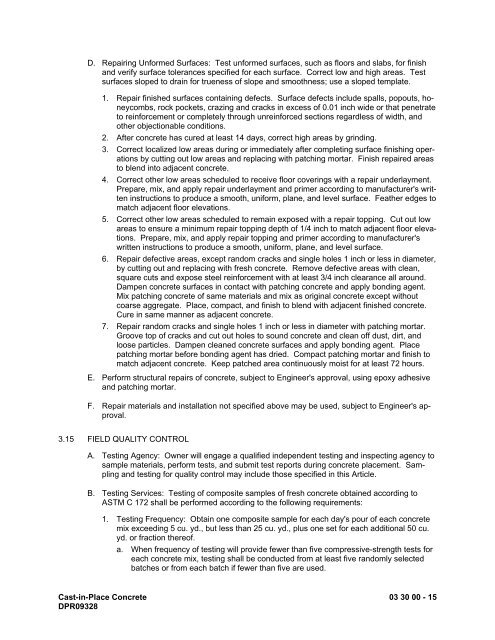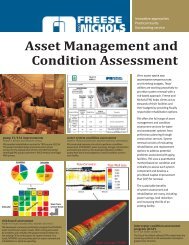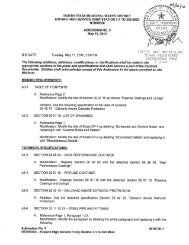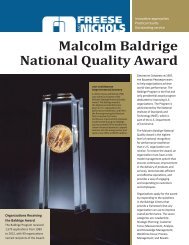final bid specs 09328.pdf - Freese and Nichols, Inc.
final bid specs 09328.pdf - Freese and Nichols, Inc.
final bid specs 09328.pdf - Freese and Nichols, Inc.
You also want an ePaper? Increase the reach of your titles
YUMPU automatically turns print PDFs into web optimized ePapers that Google loves.
D. Repairing Unformed Surfaces: Test unformed surfaces, such as floors <strong>and</strong> slabs, for finish<br />
<strong>and</strong> verify surface tolerances specified for each surface. Correct low <strong>and</strong> high areas. Test<br />
surfaces sloped to drain for trueness of slope <strong>and</strong> smoothness; use a sloped template.<br />
1. Repair finished surfaces containing defects. Surface defects include spalls, popouts, honeycombs,<br />
rock pockets, crazing <strong>and</strong> cracks in excess of 0.01 inch wide or that penetrate<br />
to reinforcement or completely through unreinforced sections regardless of width, <strong>and</strong><br />
other objectionable conditions.<br />
2. After concrete has cured at least 14 days, correct high areas by grinding.<br />
3. Correct localized low areas during or immediately after completing surface finishing operations<br />
by cutting out low areas <strong>and</strong> replacing with patching mortar. Finish repaired areas<br />
to blend into adjacent concrete.<br />
4. Correct other low areas scheduled to receive floor coverings with a repair underlayment.<br />
Prepare, mix, <strong>and</strong> apply repair underlayment <strong>and</strong> primer according to manufacturer's written<br />
instructions to produce a smooth, uniform, plane, <strong>and</strong> level surface. Feather edges to<br />
match adjacent floor elevations.<br />
5. Correct other low areas scheduled to remain exposed with a repair topping. Cut out low<br />
areas to ensure a minimum repair topping depth of 1/4 inch to match adjacent floor elevations.<br />
Prepare, mix, <strong>and</strong> apply repair topping <strong>and</strong> primer according to manufacturer's<br />
written instructions to produce a smooth, uniform, plane, <strong>and</strong> level surface.<br />
6. Repair defective areas, except r<strong>and</strong>om cracks <strong>and</strong> single holes 1 inch or less in diameter,<br />
by cutting out <strong>and</strong> replacing with fresh concrete. Remove defective areas with clean,<br />
square cuts <strong>and</strong> expose steel reinforcement with at least 3/4 inch clearance all around.<br />
Dampen concrete surfaces in contact with patching concrete <strong>and</strong> apply bonding agent.<br />
Mix patching concrete of same materials <strong>and</strong> mix as original concrete except without<br />
coarse aggregate. Place, compact, <strong>and</strong> finish to blend with adjacent finished concrete.<br />
Cure in same manner as adjacent concrete.<br />
7. Repair r<strong>and</strong>om cracks <strong>and</strong> single holes 1 inch or less in diameter with patching mortar.<br />
Groove top of cracks <strong>and</strong> cut out holes to sound concrete <strong>and</strong> clean off dust, dirt, <strong>and</strong><br />
loose particles. Dampen cleaned concrete surfaces <strong>and</strong> apply bonding agent. Place<br />
patching mortar before bonding agent has dried. Compact patching mortar <strong>and</strong> finish to<br />
match adjacent concrete. Keep patched area continuously moist for at least 72 hours.<br />
E. Perform structural repairs of concrete, subject to Engineer's approval, using epoxy adhesive<br />
<strong>and</strong> patching mortar.<br />
F. Repair materials <strong>and</strong> installation not specified above may be used, subject to Engineer's approval.<br />
3.15 FIELD QUALITY CONTROL<br />
A. Testing Agency: Owner will engage a qualified independent testing <strong>and</strong> inspecting agency to<br />
sample materials, perform tests, <strong>and</strong> submit test reports during concrete placement. Sampling<br />
<strong>and</strong> testing for quality control may include those specified in this Article.<br />
B. Testing Services: Testing of composite samples of fresh concrete obtained according to<br />
ASTM C 172 shall be performed according to the following requirements:<br />
1. Testing Frequency: Obtain one composite sample for each day's pour of each concrete<br />
mix exceeding 5 cu. yd., but less than 25 cu. yd., plus one set for each additional 50 cu.<br />
yd. or fraction thereof.<br />
a. When frequency of testing will provide fewer than five compressive-strength tests for<br />
each concrete mix, testing shall be conducted from at least five r<strong>and</strong>omly selected<br />
batches or from each batch if fewer than five are used.<br />
Cast-in-Place Concrete 03 30 00 - 15<br />
DPR09328












